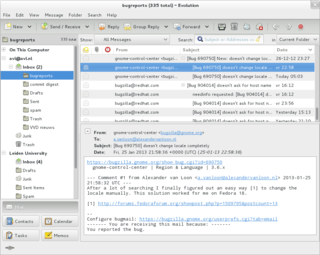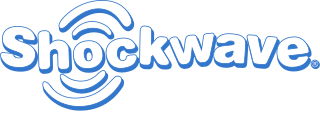Related Research Articles

AOL is an American web portal and online service provider based in New York City, and a brand marketed by Yahoo! Inc.

Email is a method of transmitting and receiving messages using electronic devices. It was conceived in the late–20th century as the digital version of, or counterpart to, mail. Email is a ubiquitous and very widely used communication medium; in current use, an email address is often treated as a basic and necessary part of many processes in business, commerce, government, education, entertainment, and other spheres of daily life in most countries.

Hypertext Transfer Protocol Secure (HTTPS) is an extension of the Hypertext Transfer Protocol (HTTP). It uses encryption for secure communication over a computer network, and is widely used on the Internet. In HTTPS, the communication protocol is encrypted using Transport Layer Security (TLS) or, formerly, Secure Sockets Layer (SSL). The protocol is therefore also referred to as HTTP over TLS, or HTTP over SSL.

The Internet is the global system of interconnected computer networks that uses the Internet protocol suite (TCP/IP) to communicate between networks and devices. It is a network of networks that consists of private, public, academic, business, and government networks of local to global scope, linked by a broad array of electronic, wireless, and optical networking technologies. The Internet carries a vast range of information resources and services, such as the interlinked hypertext documents and applications of the World Wide Web (WWW), electronic mail, internet telephony, and file sharing.

Lycos, Inc., is a web search engine and web portal established in 1994, spun out of Carnegie Mellon University. Lycos also encompasses a network of email, web hosting, social networking, and entertainment websites. The company is based in Waltham, Massachusetts, and is a subsidiary of Ybrant Digital.
Shareware is a type of proprietary software that is initially shared by the owner for trial use at little or no cost. Often the software has limited functionality or incomplete documentation until the user sends payment to the software developer. Shareware is often offered as a download from a website. Shareware differs from freeware, which is fully-featured software distributed at no cost to the user but without source code being made available; and free and open-source software, in which the source code is freely available for anyone to inspect and alter.

CompuServe, Inc. was an American Internet company that provided an eponymous online service, the first major commercial one in the world. It opened in 1969 as a timesharing and remote access service marketed to corporations. After a successful 1979 venture selling otherwise under-utilized after-hours time to Radio Shack customers, the system was opened to the public, roughly the same time as The Source.

In computer networking, a proxy server is a server application that acts as an intermediary between a client requesting a resource and the server providing that resource. It improves privacy, security, and possibly performance in the process.
An online service provider (OSP) can, for example, be an Internet service provider, an email provider, a news provider (press), an entertainment provider, a search engine, an e-commerce site, an online banking site, a health site, an official government site, social media, a wiki, or a Usenet newsgroup.

Prodigy Communications Corporation was an online service from 1984 to 2001 that offered its subscribers access to a broad range of networked services. It was one of the major internet service providers of the 1990s.

ZDNET is a business technology news website owned and operated by Ziff Davis. The brand was founded on April 1, 1991, as a general interest technology portal from Ziff Davis and evolved into an enterprise IT-focused online publication. After being under the ownership of CNET Networks (2000–2008), CBS Corporation (2008–2020), and Red Ventures (2020–2024), ZDNET was reacquired by Ziff Davis in August 2024. CNET was included in the acquisition as well.
GeoCities, later Yahoo! GeoCities, was a web hosting service that allowed users to create and publish websites for free and to browse user-created websites by their theme or interest, active from 1994 to 2009. GeoCities was started in November 1994 by David Bohnett and John Rezner, and was named Beverly Hills Internet briefly before being renamed GeoCities. On January 28, 1999, it was acquired by Yahoo!, at which time it was reportedly the third-most visited website on the World Wide Web.
Nando was an American internet news service and Internet service provider (ISP), founded in 1993 by the publishers of The News & Observer newspaper in Raleigh, North Carolina. Initially it relied on access via bulletin board technology. One of the first 24-hour news websites, the Nando Times, was launched in 1994, providing edited information from major news agencies that had not then developed their own websites.
Internet pornography is any pornography that is accessible over the Internet; primarily via websites, FTP connections, peer-to-peer file sharing, or Usenet newsgroups. The greater accessibility of the World Wide Web from the late 1990s led to an incremental growth of Internet pornography, the use of which among adolescents and adults has since become increasingly popular.

Bomis, Inc. was a dot-com company best known for supporting the creations of free-content online-encyclopedia projects Nupedia and Wikipedia. It was co-founded in 1996 by Jimmy Wales, Tim Shell, and Michael Davis. By 2007, the company was inactive, with its Wikipedia-related resources transferred to the Wikimedia Foundation.
The Pipeline was one of the earliest American Internet service providers. It was founded in December 1993 in New York City by the science and technology writer James Gleick and computer programmer Uday Ivatury, who had met at the Manhattan Bridge Club and shared an interest in online bridge. Both men believed that a graphical user interface would make the Internet more widely accessible than the command-line Unix commands that were then generally necessary.

Yahoo! Kids was a public web portal provided by Yahoo! to find age-appropriate online content for children between the ages of 4 and 13. It was available in English and in Korean.

Shockwave.com, or Shockwave, is an online and offline video games distributor and game portal. It is owned by Shockwave LLC, based in Los Angeles, California, United States. It was launched by Macromedia on August 2, 1999, to promote the company's Shockwave and Flash players, both used on the website. As of 2005, the website had 22 million users. By 2010, it hosted more than 400 games in a variety of genres.
AOL Hometown was a web hosting service offered by AOL. It offered 12 megabytes of server space for AOL subscribers to publish their own websites, and included a 10-step form-driven page creator called 1-2-3 Publish and a WYSIWYG online website builder called Easy Designer, neither of which required knowledge of HTML. In 2001, AOL Hometown estimatedly had 11 million websites and a new website was added to it every eight seconds. By 2002, AOL Hometown had grown to 14 million websites. It was shut down on 31 October 2008.

MSN Dial-up is an Internet service provider operated by Microsoft in the United States and formerly also in several other countries. Originally named The Microsoft Network, it debuted as a proprietary online service on August 24, 1995, to coincide with the release of Windows 95. In 1996 and 1997, a revised web-based version of the ISP was an early experiment at interactive multimedia content on the Internet.
References
- 1 2 3 4 5 6 Valauskas, Edward J. (July 1, 1995). "Women's Wire: Hassle-Free Online Information and Internet Access". Online.
- 1 2 Maddox, Kate (June 1998). "Ellen Pack" . Advertising Age. 69 (22): 22 – via EBSCOhost.
- 1 2 Koenenn, Connie (February 24, 1994). "Chatting the High-Teach Way, on the Women's Wire". The Los Angeles Times. Retrieved October 11, 2018– via Newspapers.com.
- 1 2 Guglielmo, Connie (May 17, 1999). "Ellen Pack" . Inter@ctive Week. 6 (20): 8 – via EBSCOhost.
- 1 2 Losee, Stephanie (July 11, 1994). "Women's Wire" . Fortune. 130 (1): 118–119 – via EBSCOhost.
- ↑ "'WIRE' Opens Doors Online". Information Today.
- 1 2 3 4 Schmit, Julie (January 14, 1996). "Women's Magazine Turns Pages on World Wide Web". Newspapers.com. Retrieved October 11, 2018.
- 1 2 3 4 5 Ness, Carol (December 12, 1994). "Women Get 'Own Room' On Superhighway". The Kokomo Tribune. Retrieved October 11, 2018– via Newspapers.com.
- 1 2 Weise, Elizabeth (October 24, 1993). "WIRE'd Women". The Montgomery Advertiser. Retrieved October 9, 2018– via Newspapers.com.
- ↑ "Wired Women of the Internet". The Paducah Sun. October 16, 1996. Retrieved October 11, 2018– via Newspapers.com.
- 1 2 3 Evans 2018, p. 206.
- 1 2 3 4 "Computer Address Case Settled". The Indianapolis News. February 21, 1994. Retrieved October 11, 2018– via Newspapers.com.
- ↑ McDaniel, Marleen (December 3, 1997). "A Safe Place Not to Browse" . Forbes ASAP. 160: 26–28 – via EBSCOhost.
- 1 2 3 Evans 2018, p. 207.
- 1 2 3 4 "Women's Wire Gets Serious About Business". The Tampa Tribune. August 19, 1996. Retrieved October 11, 2018– via Newspapers.com.
- 1 2 Plotnikoff, David (October 29, 1995). "An On-Line Pioneer for Women Pulls the Plug". The Central New Jersey Home News. Retrieved October 11, 2018– via Newspapers.com.
- ↑ Evans 2018, p. 213.
- 1 2 Leigh, Suzanne (January 14, 2007). "ReinventYourself.com / Where'd the dotshots of the '90s land?". SFGate. Retrieved October 9, 2018.
- ↑ Piller, Charles (May 30, 2000). "Sites Struggle as They Connect Women to Web". The Los Angeles Times. p. A1. Retrieved October 11, 2018– via Newspapers.com. and "Women: Sites in Search of Financial Success". The Los Angeles Times. May 30, 2000. p. A7. Retrieved October 11, 2018– via Newspapers.com.
- ↑ McUsic, Teresa (June 9, 1997). "Directory a Guide to E-mail for the Female". The Akron Beacon Journal. Retrieved October 9, 2018– via Newspapers.com.
- 1 2 3 Seo, Diane (July 23, 1999). "Rivals Battle to Be New Online Force". The Los Angeles Times. Retrieved October 11, 2018– via Newspapers.com. and "Internet: Web Firms IVillage, Women.com Have Their Sites Set on Gender Networking". The Los Angeles Times. July 23, 1999. p. C8. Retrieved October 11, 2018– via Newspapers.com.
- ↑ "Media Insight Women.com Networks". PR News. February 15, 1999.
- 1 2 "iVillage Buys Rival Women.com". The Online Reporter. February 12, 2001.
- ↑ Hart, Marion (May 3, 1996). "Women's Wire". EW.com. Retrieved October 11, 2018.
- ↑ Pawlak, Jim (September 15, 1997). "Web Sites Give Advice About Career Issues". Detroit Free Press. Retrieved October 11, 2018– via Newspapers.com.
- ↑ Simmers, Tim (February 10, 1997). "Female Point of View Online". Arizona Republic. Retrieved October 11, 2018– via Newspapers.com.
- ↑ "Wired Women News". Arizona Republic. July 15, 1996. Retrieved October 11, 2018– via Newspapers.com.
- 1 2 "Women Work the Web". The Ottawa Citizen. August 6, 1999. Retrieved October 11, 2018– via Newspapers.com. and "Web: Emphasis on Friendship and Family". The Ottawa Citizen. August 6, 1999. p. C9. Retrieved October 11, 2018– via Newspapers.com.
- 1 2 Lorek, L.A. (February 20, 2000). "Sites Targeting Women and Their Interests". South Florida Sun Sentinel. Retrieved October 11, 2018– via Newspapers.com.
- ↑ Bennett, Johanna (January 11, 1998). "Internet Wakes Up To Women". The San Francisco Examiner. Retrieved October 11, 2018– via Newspapers.com.
- ↑ Evans 2018, p. 208.
- ↑ Evans 2018, p. 209-210.
- ↑ Evans 2018, p. 212.
Sources
- Evans, Claire L. (2018). Broad Band: The Untold Story of the Women Who Made the Internet. New York: Portfolio/Penguin. ISBN 9780735211759.